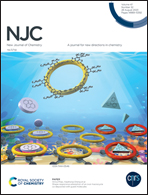Green synthesis of M-type manganese-substituted strontium hexaferrite SrMnxFe12−xO19 nanoparticles with intrinsic antibacterial activity against human pathogenic bacteria†
Abstract
Green synthesis methods for inorganic nanomaterials have attracted attention due to their effectiveness and suitability for large-scale production. These methods are preferred over conventional chemical and physical approaches, which tend to be more costly and pose environmental hazards. Herein, M-type manganese-substituted strontium hexaferrite nanoparticles, SrMnxFe12−xO19 (SMHF), were successfully synthesized using chemical and green-based sol–gel auto-combustion routes. The chemical route was citric acid-based (SMHF-C) and the green synthesis was based on using pomegranate (SMHF-P) and lemon juice (SMHF-L). Various microscopy and spectroscopy methods were extensively utilized to comprehensively examine the chemical composition, crystalline structure, magnetic properties, and morphology of the SMHFs. The antibacterial activities of all the SMHF NPs were examined using the well diffusion assay (WDA). The minimum inhibitory concentration (MIC) and minimum bactericidal concentration (MBC) are determined for SMHF-P. The proposed mechanism for the antibacterial activity of SMHF suggests that it can damage the cell wall, leading to the death of the bacterial cells and cytoplasmic leakage. The findings indicate that the increased antibacterial activity of SMHF-P is due to its high magnetic characteristics, small particle size, large surface area, and mesoporous properties.



 Please wait while we load your content...
Please wait while we load your content...